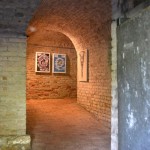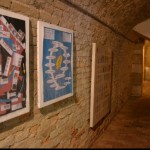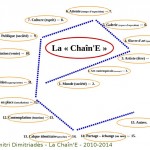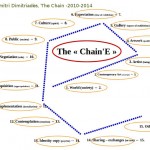Statement pronounced during the varnishing of the exhibition ” Mais-L’Ange “, at the Radbühne of Neuf-Brisach (France) on September 20th, 2014
- L’entrée de l’exposition / The entry of the exhibition
- Le 2nd couloir / The second corridor
- Détail de “La Chaîn’E” (Français)
- Detail the Chain.
1. Introduction
2. The question of the New
2. 1. A New spirit (not pronounced during the declaration)
2. 2. The New: an appearance
2. 3. The letter “e” in the “Project e”
2. 4. « The something else »
3. The question of the “Whole”
3. 1. The « Chain »
3. 2. In the heart of the problem
4. The origins of the “Project E’ye” : a frieze
4.1.The qualities of the frieze
4.2. The question of the climate
4.3. The thickness of Time
4.4. The first series E’ye I – 1
Notes and references
* * *
1. Introduction
It seems to me that it is essential to introduce the “word” into the art. It is the purpose of this artist statement who will point to three directions which guided the elaboration of the work you have in front of you. Namely:
1. The question of the New ;
2. The question of the Whole ;
3. « The E’ye project: What is art ? » What is the role of the Art ? And consequently the role of the Artist ?
The statement becomes also an illustration of my method of work…
* * *
2. The question of the New
When I was in the Arts faculty. The professors often told me, about my proposals : ” That (the work) It was already done… That also…” It was difficult to come up with new proposals. (I insist on this point, because it seems to me that the art is especially a question of novelty.)
It is necessary to say that from historic point of view, the XXth century was an incredible explosion of permanent novelty. We can not count the movements and groups of artists.
And, at the same time, I am sad to notice that today, all these combined efforts of all these artistic discoveries did not make a lasting universal peace. (I also insist on this point, because it seems to me that the art it is also a question of peace.)
* * *
2. 1. A New spirit (not pronounced during the declaration)
*
2. 2. The New: an appearance
Meanwhile, I was not discouraged.
I continued my quest on the “new”, while knowing that the “new” raises problem, because it confuses the audience.
The poet Rilke speaks in this terms, in his “Letter to a Young Poet”: The new is there before you, he looks at you …
It is as a matter of fact an appearance …
Then, how can it be done ?
Always pursue. Live with this appearance.
I spoke in the singular, but in reality, we must speak in the plural. It is often a “family of appearance.” I thus found, for example, by moving in a given system [A], an element, we obtain a new system [B].
Saving you important details (the value of cinema and cinematic vision. – And therefore the movement.) We arrive at the “Project e”.
*
2. 3. The letter “e” in the “Project e”
So for example, in the beginning, the letter “e” in the title “project e” was a word of 5 letters. I hid 4 letters, by keeping only the first letter, to obtain the “Project e”. And suddenly, I got “something else”, something unexpected.
And here are the two key words that can define the “New”, “the new is something else.”
In short this “gymnastics” of “the something else” is going to give, in part, what we have in front of us.
*
2. 4. « The something else »
As I have just said it, “the something else” began to generate a dynamics (horizontal and vertical) unexpected and unpredictable that it was important to take into consideration.
*
[2]
*
I quote some projects fruit from the principle of “something else”:
1. The “E’ntraînement” (Training) project, an association between the art, the martial arts and the religion. The idea was to train, unexpectedly, on a Saturday afternoon, a voluntary public in a city center.
Subsequently, I proposed the project to the government, but in vain …
2. The “Ouvertur’E” (Opening) project. Pass (as not telling to give) a work during an exhibition of drawings to passing visitors. There were 42 drawings that were given.
3. E’nvoi (Sending) project: the gift of a work of art in a single click.
* * *
3. The question of the “Whole”
In summary, the “new” consists in not making as the others. If I consider the « Chain’e » of the Equation data on art. It is enough to make a change inside the chain and we end up with the a new data.
The « Chain’e » is a great opportunity to introduce the second point of my statement: The question of the “Whole”.
*
3. 1. The « Chain »
The « Chain’E » is almost a whole of what can represent the art and the artist (it is the third point of my statement.) (See Illustration)
I just said “almost” because it has been shown that the “whole” is neither given nor donnable (Henri Bergson). Why? Gilles Deleuze responds, it is because it is the Open, and because it is up to him to keep changing or bring out something new, in brief to last. [3]
We note that inside the answer of Deleuze, we obtain a significant relationship between the “whole” and the “new”: it is from a whole, or from its approach, that we can see arise something new.
*
3. 2. In the heart of the problem
So when I say “everything”, it is about an extension of a globalizing panoramic projection. To illustrate this idea, I will tell a little story, and I quote again, depending on the circumstances in front my students : A work of art today must contain both the Old and New Testament, the Iliad and the Odyssey, as well as other cultural monuments.
And in fact, if we look at the “Project E’ye: What is Art ?” We obtain an explicit example of what I just said. It contains both the Old and New Testament, the Iliad and the Odyssey, as well as monuments of universal art.
* * *
4. The origins of the “Project E’ye” : a frieze
Initially, I noticed that it was difficult to speak about a work in front of students without indicating it.
I began then to study the question of a frieze of art history which goes back up from the origins to the present day. The frieze ran along the walls of the room. It was divided into three horizontal bands of equal size which included three registers: 1. Painting; 2. Architecture; 3. Other (sculpture, photography, object)
*
4.1.The qualities of the frieze
The frieze allowed me to jump up, at any time on a given work (I did not need to look and to take out a board …) The work is there, it was exposed.
We can pull a first observation. The difference between speaking about a work and showing it. This quality is visible in the Project E’ye .
A second observation was to demonstrate to students that art does not go back up to the dawn of time (at least according to our current knowledge, which remain still hypothetical). On the scale of the age of the planet, art is relatively young.
The age of the universe 13.8 billion years
The age of the earth 4.54 billion years;
The age of humanity 2.9 million years;
The current European climate: 80,000 years.
The art therefore does not appear until the third millennium in the West (fifth in China).
*
4.2. The question of the climate
The beginnings of art were only possible from a certain mastery of domestic life. It was necessary to find accommodation at first, to feed, etc. But you can see immediately, that for housing, food and drink, art is already present, there was from the beginning an intimate association between art and the birth of humanity.
The current climate goes back to the eighth millennium. It took almost 50,000 years before seeing the hatching of an artistic spirit which tries to produce original objects. In short there was originally a magical relationship between works and people which in some way disappeared.
To summarize, there has not been a “big bang” of the art world. There have been sporadic and scattered sparks in northern Europe.
The real art outbreaks will take hold from a necessary condition: the sweetness of a temperate climate : Egypt, Mesopotamia, the Cyclades, Greece, Italy. Thus, the warmth of these regions reflect the incandescent heat of the arts.
*
4.3. The thickness of Time
It is then necessary to imagine the exceptional exploit of these men who had to, ceaselessly, invent the whole artistic universe.
Human beings extra or extra-human beings.
I began to realize that I worked “the thickness of the artistic time.”
I realized, too, that it was important to show that work to the greatest number, that it was a part of my artist’s role, to draw the attention of the people on the art and the major works of Art.
I decided in 2012, to consider the whole artistic world as a ” object of reflection “, to work the thickness of the art.
But, I did not want to make a work of documentation which remains a little bit cold for me.
At the same time, I began to be interested in diamond shape. It was enough to add a horizontal bar to the upper level of a rhombus to suggest the shape of a diamond.
*
4.4. The first series E’ye I – 1
There (with diamond format), I was convinced between the shape of the support and the artistic background which is a treasure : Art is as precious as a diamond.
This I also wanted to show it to people.
Then, there was the problem of the parts numbers (works).
I took back the 8 components of an upper-case E.
My concern was always to show a selection of works from the origins until our days.
I must point out that for the frieze in the college, I already had a list of 136 masterpieces.
However, I found that for the first series of 16 pieces, it was not possible to cite the major disciplines of the arts: painting, architecture, sculpture, etc.
I decided for the first series to include only painting, performing as much as possible, a mathematical distribution which includes 30,000 years of art history.
* * *
Notes and references
We have not seen the synthesis of this accumulation of cultural wealth.
In brief, I believe that we see where I am going to come there …
Let us try to launch a qualifier in our present time, by taking into account what I have just said : I risk with “a new economic spirit “. The economy dominates the world : it is the law of the market, the offer and the demand, the production and the consumption, etc.
Have you noticed that in the chosen name, there is a contradiction : indeed, can we combine “spirit” and “economy” ? The “sacred” and “secular” ? Are they compatible ? (We will not answer the question today.)
In this regard, I would say that Fleming find penicillin inadvertently (he was brilliant, but neglecting), Columbus, the push of Archimedes, they made “something else”, they noticed “something else”.



